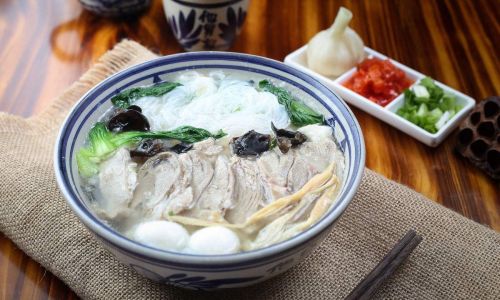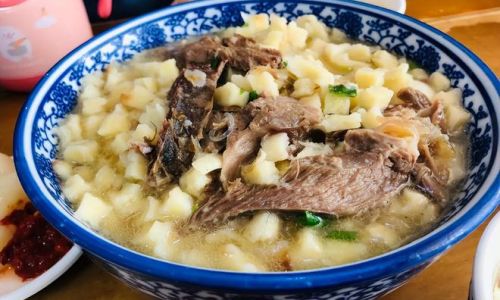Introduction
Mutton stew bubble bread, commonly known as Yangrou Paomo in its native China, is a culinary delight that combines the rich, earthy flavors of mutton stew with the soft, absorbent texture of torn bread. This dish, which originated in the Shaanxi province of China, is not just a meal; it’s a culinary journey through history, tradition, and flavor. Making Yangrou Paomo at home can be a rewarding experience, but achieving that perfect balance of flavors and textures requires a bit of know-how. In this article, we’ll delve into the intricacies of crafting a delicious Yangrou Paomo, from selecting the right ingredients to perfecting the cooking process.
Ingredients Selection
The foundation of any great dish lies in its ingredients, and Yangrou Paomo is no exception. Here’s a breakdown of what you’ll need:

-
Mutton: Choose high-quality mutton with a good fat-to-meat ratio. The fat adds flavor and moisture to the stew, making it more tender and juicy. Look for cuts like shoulder or leg, which are ideal for slow cooking.
-
Bread: Traditionally, Yangrou Paomo uses a type of Chinese bread known as “Mo,” which is slightly sweet and slightly dense. However, you can use any sturdy, slightly stale bread, such as French baguette or Italian ciabatta, as long as it can absorb the stew without becoming soggy.
-
Aromatics: Garlic, ginger, and scallions are essential for adding depth and complexity to the stew. Fresh herbs like cilantro or parsley can also be used for garnish.
-
Spices: Shaanxi-style Yangrou Paomo relies heavily on spices like Sichuan peppercorns, fennel seeds, cinnamon, and star anise. These spices not only flavor the stew but also contribute to its unique aroma.
-
Vegetables: Carrots, celery, and onions are common additions that provide sweetness, crunch, and bulk to the stew.
-
Broth: Chicken or beef broth can be used as a base, but for authenticity, consider using mutton broth or a combination of both mutton and beef broth.
-
Seasonings: Soy sauce, rice vinegar, and sesame oil are used to season the stew, while chili oil or flakes can be added for a spicy kick.
Preparation Steps
Now that you have your ingredients, let’s dive into the preparation process.
-
Preparing the Mutton:
- Cut the mutton into bite-sized pieces, removing any excess fat or sinew.
- Blanch the mutton in boiling water for a few minutes to remove impurities and blood. Drain and set aside.
-
Making the Broth:
- In a large pot, combine the blanched mutton, chopped vegetables (carrots, celery, onions), aromatics (garlic, ginger), and spices (Sichuan peppercorns, fennel seeds, cinnamon, star anise).
- Pour in enough broth to cover the ingredients by at least an inch. Bring to a boil, then reduce to a simmer.
- Skim off any foam that rises to the surface and continue simmering for about 2-3 hours, or until the mutton is tender and the broth is flavorful.
-
Preparing the Bread:

- While the stew is simmering, tear the bread into bite-sized pieces. You can do this by hand or use a knife to cut it into small cubes.
- Toast the bread pieces lightly in a pan or oven until they are slightly crispy on the outside but still soft inside. This will help them absorb the stew better without becoming too soggy.
-
Seasoning the Stew:
- Once the mutton is tender, remove it from the pot and set aside. Strain the broth, discarding the vegetables and spices.
- Return the broth to the pot and add soy sauce, rice vinegar, and sesame oil to taste. Adjust the seasoning with salt and pepper as needed.
- If you prefer a thicker stew, you can mix a little cornstarch with water and add it to the broth, stirring constantly until it thickens.
-
Combining the Ingredients:
- Add the cooked mutton back into the seasoned broth and let it simmer for another 10-15 minutes to reheat and meld flavors.
- In a large serving bowl, place the toasted bread pieces. Ladle the hot mutton stew over the bread, ensuring that the bread is fully submerged and soaked up the stew.
-
Garnishing and Serving:
- Garnish the Yangrou Paomo with chopped scallions, cilantro, and a drizzle of chili oil or flakes if you like it spicy.
- Serve immediately with additional condiments like soy sauce, vinegar, or chili sauce on the side for diners to adjust the flavor to their preference.
Tips for Making Delicious Yangrou Paomo
-
Patience is Key: Slow cooking is crucial for tenderizing the mutton and developing the broth’s flavor. Don’t rush the process.
-
Quality Ingredients: Use the best quality ingredients you can afford, especially for the mutton and broth. This will make a significant difference in the final dish.
-
Toast the Bread: Toasting the bread before adding the stew helps it maintain some texture and prevents it from becoming mushy.
-
Season to Taste: Don’t be afraid to adjust the seasoning as you go. Taste the broth and stew frequently, and add more soy sauce, vinegar, or spices as needed.
-
Experiment with Garnishes: While traditional garnishes like scallions and cilantro are great, don’t hesitate to experiment with other herbs or condiments that you enjoy.
Conclusion
Making Yangrou Paomo at home is a labor of love that rewards you with a hearty, flavorful dish that’s as comforting as it is delicious. By following the steps outlined above and paying attention to ingredient quality and cooking techniques, you can create a Yangrou Paomo that rivals the best restaurants. Whether you’re enjoying it on a cold winter night or sharing it with friends and family, this traditional Shaanxi dish is sure to become a favorite in your culinary repertoire. So, gather your ingredients, roll up your sleeves, and embark on a culinary journey through the flavors of Yangrou Paomo. Bon appétit!






0 comments